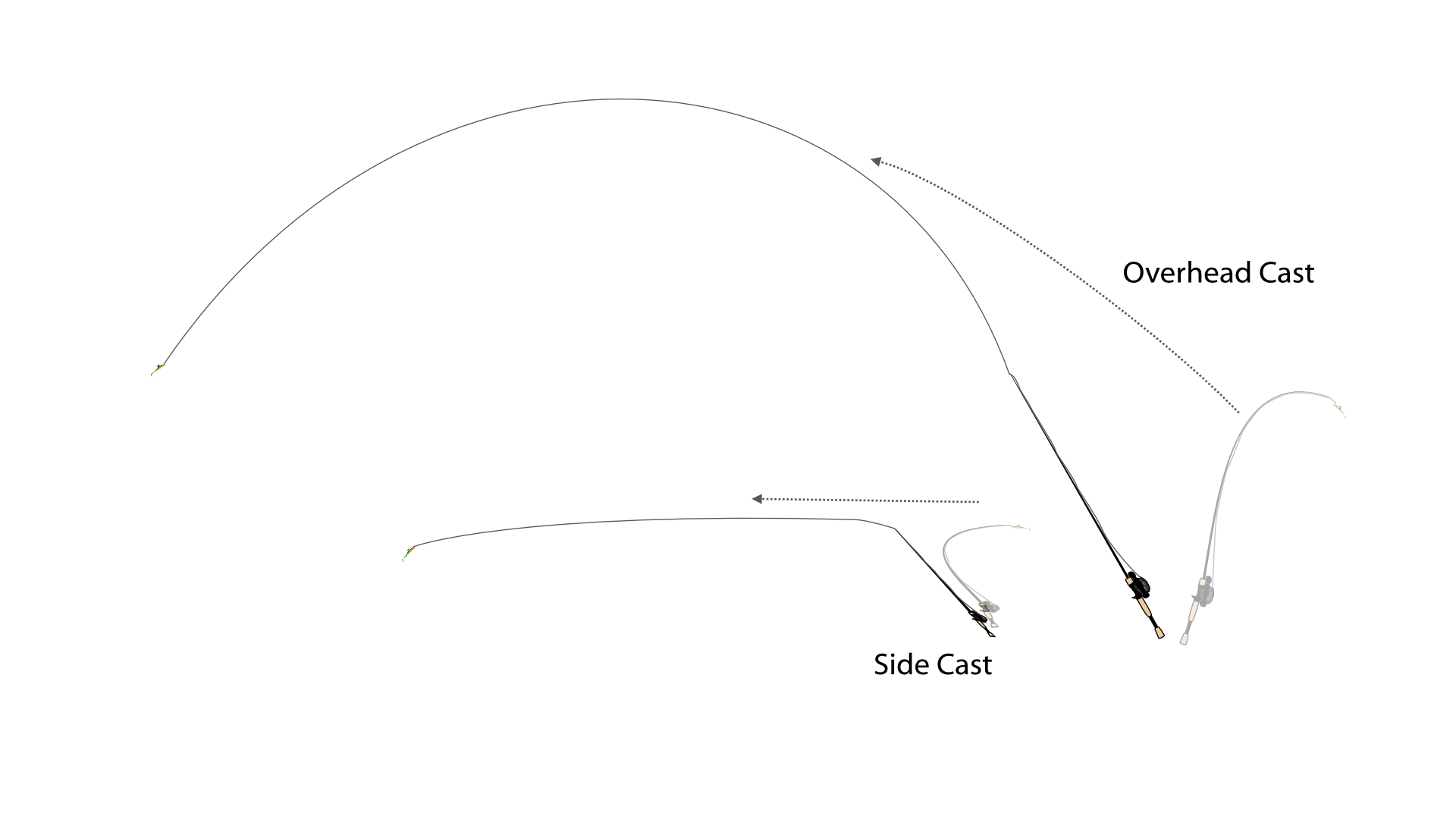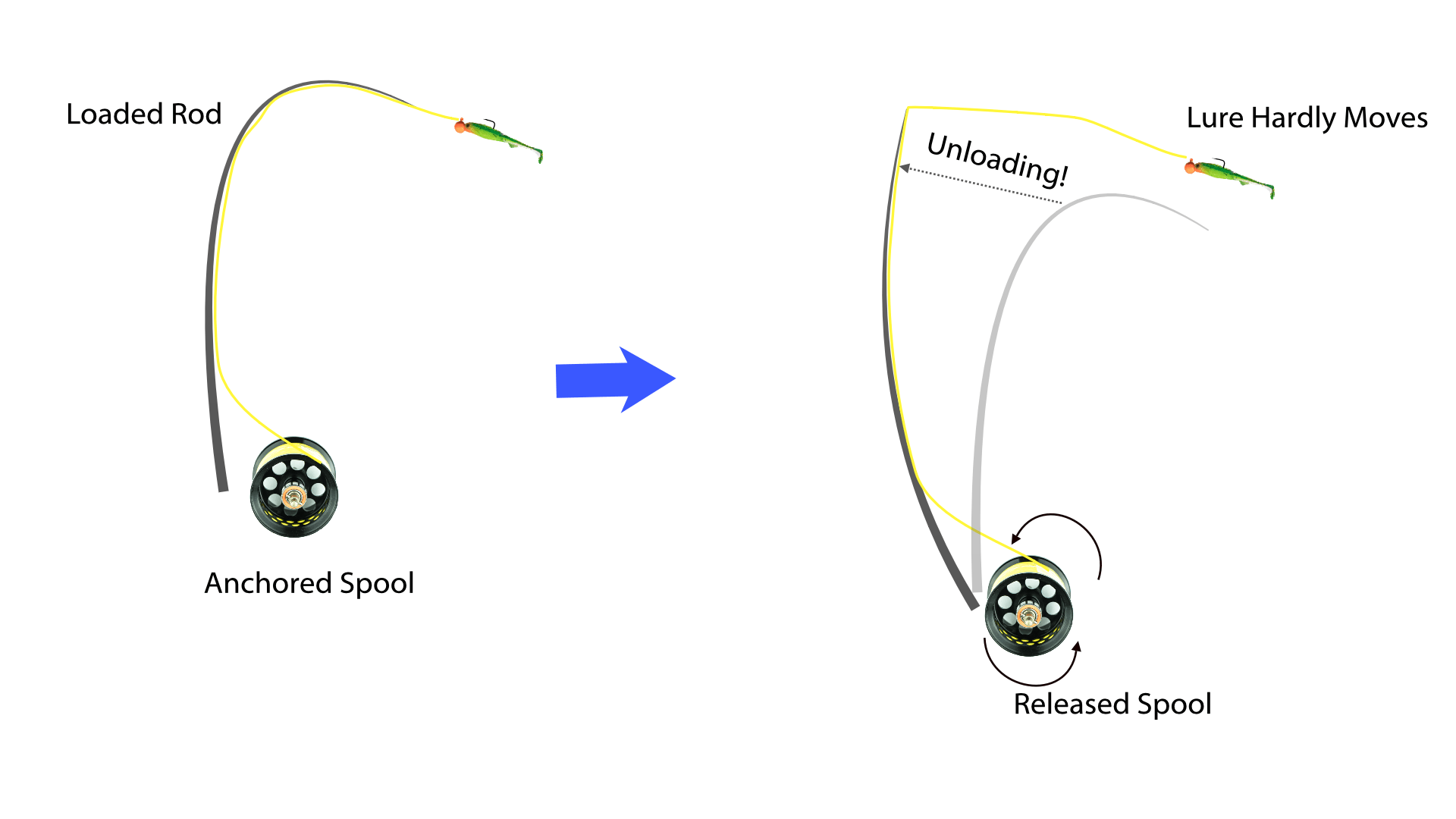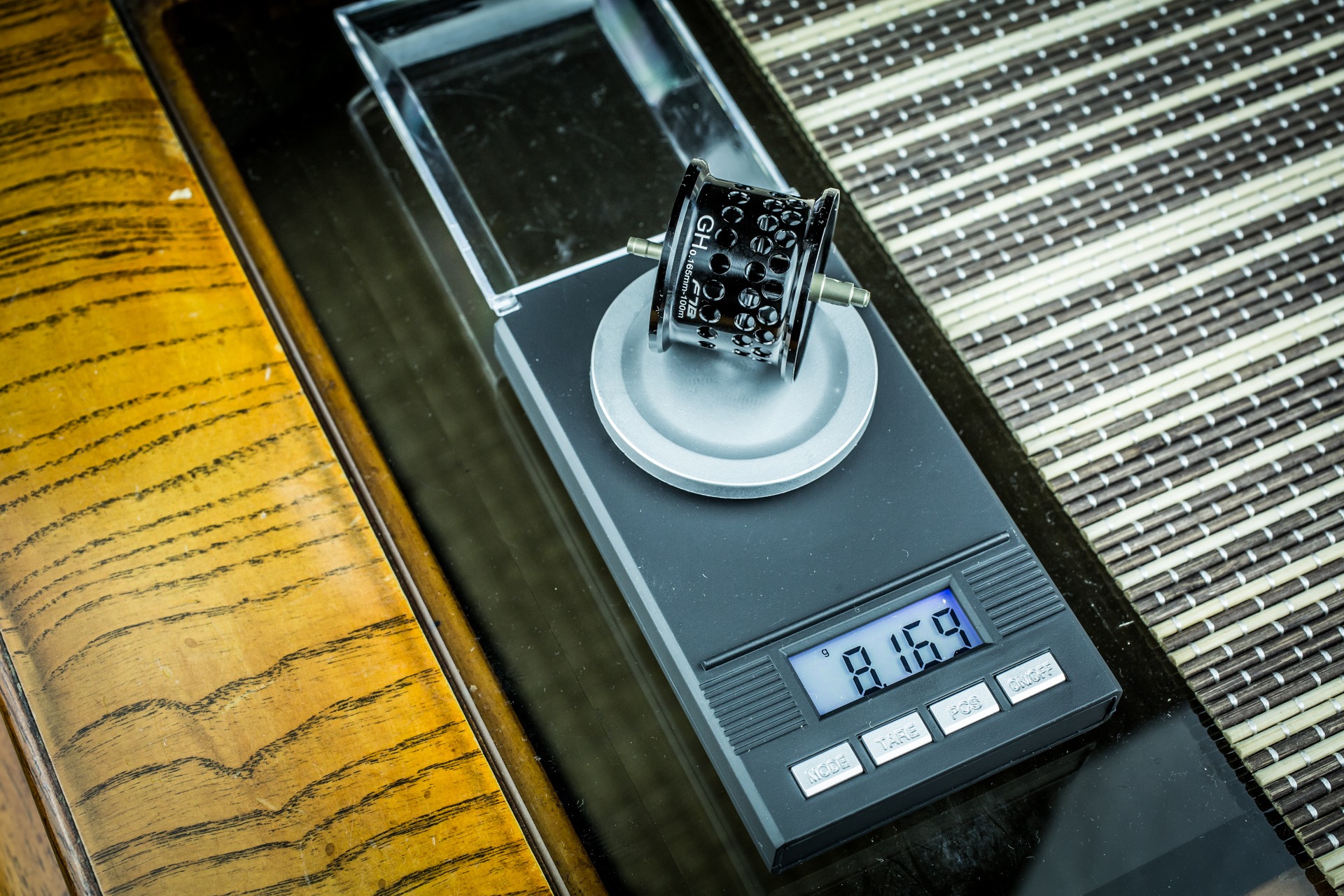How is Bait Finesse Casting Different?
Bait Finesse Casting has lots of crossover with regular baitcasting – but there are some important things to focus on to minimise frustration. Because bait finesse system (BFS) fishing uses baitcasting reels, anyone who already fishes with that style of reel will (obviously) probably find it a bit easier to adapt. It's not a problem if never picked up a baitcaster though...
As a kind of TLDR example of what its like – check out a few casts from this video. Notice how STILL the casting arm can be (and how the hand stays in the same place as the rod unloads and the thumb is released)
Do you need to be some kind of genius to learn bait finesse casting?
Don’t worry, it is perfectly possible for the average Joe to pick up and learn serviceable bait finesse casting from scratch (though to get as good as Angler Saito, it will take you your standard 10K hours of practice of course). I can re-assure you on that point because I’m writing this article while documenting my own learning curve in BFS.
That means it’s not as if I’m already a complete “guru” in this style – so the things I struggle with are likely to be the exact same things you do. In the same way, I hope the things I’ve picked up that work for me will also be super helpful to you.

If you can cast any other kind of rod & reel, there's no reason you can't learn bait finesse casting well enough to catch some lovely fish
Although common to all baitcasting – I’ve found that accuracy for shooting into gaps and keeping the lure low to the water become very important. Also, improvising to create a cast when branches or other obstacles mean you can’t pull back the rod into the obvious position is a common challenge in BFS.
Two Major Factors
The extreme light weight of the lure (perhaps down to 1g or even a bit lower, if your reel is up to it) puts a focus on loading the rod, while controlling the beginning of the cast. In fact, you have to pay more attention to matching the weight of the lure to two key parts of your rig in BFS:
- The stiffness of your rod
- The weight (inertia) of your spool and any other resistance to it beginning to turn – e.g. the bearings or any part of the drive system that the spool remains connected to during casting.
That last point might seem weird, but reels like the super-classic Abu Ambassadeurs have their line guide move back and forth during “free-spool” operation for casting.
It's worth being aware that there's an ever-growing number of budget-friendly BFS reels becoming available - possibly following the success of the Fishband GH100.

Light, shallow and ported (drilled out) spools with only as much line as you need: hallmarks of BFS casting
It also helps to choose a line that is fine diameter and, therefore, lighter for a given length. By only putting on the exact amount of line that you need – you can further minimise the weight/inertia of your spool.
A Question of Balance in bait finesse casting
With a balanced rig of lure, spool, line and rod, you can get a sense of the distinctive “feel” of bait finesse casting. This style of casting majors on loading (bending) the rod at the beginning of the cast. You do this by first moving the rod and lure AWAY from the direction you want to cast (almost like a fly fishing “back-cast”).

Make your first movement AWAY from the target - AND DON'T PAUSE before starting the forward cast
As you begin to make your forward casting movement, the bend in the rod gets deeper because of the force needed to reverse the momentum of your lure. That generates a much wider arc for you to apply power. It also means the ROD is doing most of the casting!
Although that idea is present in other branches of baitcasting, creating and controlling that flex with such light lures gives BFS casting a particular character. In fact, if you DON’T do this “loading up” action of the rod you dramatically reduce distance and accuracy.
If, instead of loading up, you try to draw the rod back – pause – and then flex the rod only on the forward cast; there is only a tiny arc of the cast where power is applied.
In fact, without loading up, most of the forward cast movement is “eaten up” by putting that bend into the rod.
It also feels a lot less forgiving of slight variations in timing when you release the spool.
On side-casts, starting without loading up makes it likely for the lure to pull to the left on a right-hand cast. By making your release-point early enough to send the cast straight, you lose most of the power-arc.
Loading up gives you a big advantage and makes sure the rod does the work. It also seems to create a bigger margin for error on your release point by reducing the amount of force you need to use in the forward cast.
Combining the ideas of loading up, letting the rod do the work, accuracy and the need to cope with obstacles behind/above you means that casts have a lot of “wrist”. It also means there probably shouldn’t be too much “arm” in the cast. I’ve found it helpful to focus on keeping the hand and arm quite “locked in place” to fire the cast out. All this means that BFS casting does feel pretty distinct from a lot of other lure fishing styles.
Basic BFS Side Cast
Below is a basic side-cast in slow motion with the affordable KastKing Zephyr (NOTE: this example is using two hands - which helps in keeping your arms from swinging around too far; but you should also practice this one-handed as well):
Side casts fly quite flat to the water while overhead casts tend to have a higher, looping flight-path (below). The flatter the flight-path – the more constant the speed of the lure. Matching the speed of the spool to the speed of the lure is how to avoid over-runs/backlashes. OK, modern magnetic brakes help a lot – but you still need to understand the difference between making the spool rotate and firing the lure forwards.

We’ll get into spool and lure movements (and rod flex) as we go on. First, a step by step checklist for a basic side-cast would be:
In fixed spool reels, it feels like you can wait for the lure to overtake the rod tip and already be moving out over the water beyond the rod before you release the line. If you try to do this with a light lure on a baitcaster, the lure will jerk against a static spool and stall.
Practicing the side cast is a great way to work on NOT using lots of long, sweeping arm movements for bait finesse casting. Putting a lot of focus on keeping elbows in and just using wrist to load the rod to fire the lure is really helpful. You can compare the release points, rod tip paths and loading/unloading of the rod between spin-casting and bait finesse casting in this short trip video of JP and myself:
Loading Up and Release Point
It is nearly all wrist movement that generates the rod-bend in bait finesse casting. You can see that really well In the video at the top of this post, as well as getting a clue from Angler Saito as to why glass rods have their fans in the BFS community! The video clearly shows how the rod is “loaded up” using a motion AWAY from the target – before reversing that movement with a forward wrist-snap.
I think the mechanics of this are a bit like a bow and arrow. In a way, you are pulling back the rod tip in the same way you draw back a bow. There is just one major complication though…the spool.
Having your thumb on the spool anchors the line – and that anchor is what lets you load up the rod as the momentum of the lure pulls on the rod tip when you start the forward “snap”.
If you release that anchor and allow the spool to start turning, the rod begins to straighten – because tension is lost.
Importantly, that tension is reduced WITHOUT the lure moving forwards very much.
Back to archery, that would be a bit like moving the hand holding your bow back towards the arrow – the bow straightens, but doesn’t fire the arrow forwards with authority...

The kicker comes from the fact that, in order to allow the lure to fly out freely, the spool obviously NEEDS to be spinning to pay out line.
Your task, then, is to release the spool early enough to combine the mass of the lure with the “pull” of the straightening rod...so it begins turning the spool before the lure gets beyond the rod tip…
At the same time, it mustn’t be so early that the lure isn’t yet going forwards fast enough – and the straightening of the rod sets the spool whizzing round viciously fast (with no movement of the lure to take up that slack!)
That last situation will give you the MOTHER of all bird’s nests…I did it recently when my lure just brushed against something as I loaded up for a flip cast. The lure stayed absolutely where it was and my rod wanged straight. Within half a second, my reel looked like a candy-floss machine operated by a maniac...
Ratio of Spool Weight to Lure Weight in Bait Finesse Casting
There’s a rough (but practical) benchmark for weights of BFS spools of around 9g or less. A 9-point-something gram spool with decent bearings should let you cast a 2g (total weight) lure fairly easily. Of course, you should be using a rod rated for something in the 1g – 6g or 1g – 8g territory.

For getting down to lures of 1g total weight, you’ll have a lot easier time with spools under 7g and certainly closer to 6g…Though, of course, the lighter you go – the more care you’ll have to use to make sure you don’t deform or damage the spool.
Timing of Release vs. Lure and Spool Weight
Based on what we know about rods unloading and spools spinning...
The lighter the lure (and/or the heavier the spool) – the earlier you’ll need to release the spool to get it spinning properly by the time the lure passes the rod tip.
The lighter the lure, the less of an “anchor” it provides to both bend the rod AND to start the spool spinning.
Of course, the flip side of that is, the heavier the lure (and lighter the spool) – the later you want to release the spool because it will begin spinning right away.
At a certain point, the force (amount of bend and how strongly you need to snap it forwards) needed to get a light lure to make the spool spin gets too much to control. The best result of that mis-match is that the spool won’t spin and the lure jerks tight against the line (which isn’t being paid out fast enough).
Alternatively, if you manage to actually throw the rod hard enough (and release your thumb EARLY enough) to get the spool spinning - the chances are that spool is going to be turning SO much faster than the lure is being thrown forwards.
Again we’ve arrived in “Destination Unholy Bird’s Nest”.
Take home messages on lure weights in bait finesse casting:
Assuming you’re happy dialling in a reel’s brakes, the best way to learn bait finesse casting style is to start out with a lure weight somewhere in the middle to upper rating for your rod.
That way, the rod will flex easily and – most importantly – you’ll be able to FEEL it flexing and straightening.
Then, making sure that your spool weight is going to be comfortable at that lure weight, you can start experimenting with a medium-strength casting stroke.
Flip Casting Special Considerations
When it comes to flip-casting, you need to raise your elbow high enough to keep the rod and lure from snagging on the water (or the ground) during the casting stroke. Either will be disastrous! You also need to get a good feel for the release point - which will vary depending on how heavy your lure is relative to your spool (and also the inertia of your bearings - with micro-bearings allowing you to release a little later). The greater the inertia you need to overcome - and the lighter your lure - the earlier you'll need to release.
Also, be aware of the plane/angle at which your rod is loading and unloading. If you have too much of an "up and down" motion, the lure is likely to fly up in the air - and cause a backlash as gravity makes it stall...Instead think almost of the feeling that you are throwing your lure away behind you on the backswing - and release just as the tension starts to build on the rod.
Here is a short (2-minute) video of some fun flip casts using an affordable combo of the Dark Wolf Ultra reel and Tsurinoya Ares C472 UL rod:
Try not to release too late - since that creates a terrible mess when your lure is already moving fast and then you suddenly release the spool. The lure jerking tight to that stationary spool when the rod is already pretty straight isn't good as you'll already know from your other casting experiences.
Tips for Practicing Bait Finesse Casting
That last point is important. Even when it seems you aren’t making progress, your body is working this stuff out while you sleep – so the next time you try it’ll be a tiny bit better. Eventually, those little improvements all add together and create a breakthrough.
Just like a stonemason hammering away at a lump of rock – the 100 blows with the hammer where the rock didn’t break are NOT wasted. In the same way, the 101st impact when the rock actually breaks is the least important one – it only happens because of the other ones that came before.
Looking into the future, I’ll try to share as much video of my own bait finesse casting to share my own progress – and I’m very open to comments/tips/assessment from folks at all points along the progress curve.
Please share your thoughts below and I’ll always try to answer you if I can offer something useful in return.
Paul

Thank you for a very well thought out article. I have always likened casting a BFS to fly casting, using the rod to shoot the lure out in a precision cast, and almost completely unlike any other cast than the stop or “knock” of a fly cast. The rod is an important part of the equation. Paired with a typical bait cast rod, a BFS reel can be over-powered and instant bird’s nest. If the tip is vibrating a lot, wobbling about after release, it can jerk the line and pulse the reel, instant bird’s nest again. A heavier reel is more tardy in its reaction and less sensitive, usually has more drag and braking, but a BFS will respond to the slightest energy input. BFS is not just about casting the very lightest lures, we may actually want the lure to sink, it is more about putting the lure where you want it, but certainly not half way across a lake.
100% agree Jeff – thanks for your comment.
Paul
Really appreciated the detailed explanation of how to cast my BFS rig. I’ve only put in a day or so of practicing and starting to get the hang of it! Once I help my elbow in and using my wrist to whip the lure, I was beginning to get more distance and hitting targets with more consistency although more practice is needed to improve accuracy! Your tips helped me build more confidence in using this new method of fishing! It was a lot of fun today when I was able to repeat my casts and not foul up the line! I’m using a Kastking Zephyr spooled with 8lb Kastking Super Power Silky braid in Grass Gree and fluorocarbon leader. For now it’s paired with a St. Croix Triumph 6’6” Medium Power Fast Action rod. In time I’m considering buying the OLD 18 7’ Ascent BFS ultra fast rod and give that a try.
Thank you again for your advice in helping me to get started using and having fun with this new equipment!
[…] Bait Finesse Casting: Tips from the Trenches to Help you Get Good […]
I have been using BFS for about 4 years, starting with an Aldebaran MG7 and Avail spool. I have learned a lot, but this post helped pull some aspects of BFS into better focus. Thanks!
You’re really welcome Jay – thank you too for making a great contribution to the conversation.
Paul
Great stuff! Thank you!
I’m enjoying BFS with a “real” BFS set-up: Daiwa PXL Type R and Major Craft Volkey 6′ 2″ L BFS rod. (I also have a Daiwa Alphas SV105 reel.)
But I’m enjoying it just as much with Tsurinoya XF50, Tsurinoya Spirit Fox, Fishband GH100, KastKing Zephyr, and Fishband PW100 reels and Kuying Teton, Ace Hawk Cu Double and Tsurinoya Pro Flex II C632UL rods. I have upgraded the bearings in most of the reels and the spools in a couple of them.
I got all of these budget BFS rods and reels for less than the price of the PXL/Volkey outfit and I have at least as much fun with them!
Bob – that is really cool and it is great encouragement for the growing number of people who would like to give BFS a try – but might be intimidated by the price tag of high-end Japanese gear.
Of course, premium gear is wonderful; but as you say – the fact that you can have a great experience without breaking the bank is a great thing for anyone just wanting to try it out before committing to a big investment.
Thanks for posting your comment – as I hope it might give someone else the confidence to try out a new fishing adventure.
Paul
Great stuff! I’d love to know about the availability of short, softer-action glass rods in the uk. The sort I think they call “trout” BFS rods in Japan. Some on eBay (ie Shimano Cardiff), but expensive, and worrying stuff about unspecified import duty/tax etc to pay.
Hi Luke – yes, I’ll try to build up a bit of a compendium of info on this style of rod. In the meantime:
For Japanese imports, yes you’ll often get stung for import duty (and the associated “processing fee”) which is something I got very used to with tenkara rods…
The Anglo & Company glass rods used by Angler Saito are made in small batches in Japan and have an obviously premium price tag.
John has the Cardiff and enjoys it very much
My own glass BFS rod was built in England by Darren Keats of Resilure on an S-glass blank – and it has excellent performance (without the import duty or Anglo & Company starting price)f
I also very much enjoy the soft, through action of the one-piece, plus-handle (4’7″) carbon rod made by Tsurinoya – The C472 UL “Ares” rated for 1-6g
Hi Paul
As always a well thought out and well put article.
Having only had two outings and five minutes in the back garden with my Zephyr reel and Max Steel rod a couple of things came to light.
Firstly, starting to use BFS gear with a size 0 Mepps on a narrow, overgrown stream is really hard ! If you try to baby the cast it flies left every time when you only have a stream 10m wide, or less, with overhanging trees.
The one stretch that is open for 30m and you can punch the cast is much easier to control because the lure is in the air for so much longer.
The unspoken truth seems to be that regardless of brake settings on cheaper reels it’s all about the thumb !!
Definitely starting out on an overgrown stream is a fairly bold move!
Other things I’ve found is that – for light lure casting – the action and stiffness of the rod is at least as important as the reel. Also, the backswing/load-up before the forward cast is an important factor in combatting things flying left.
I hope you continue to enjoy your BFS exploration
Paul
Man just a short read of this and I’ve already figured it out in the backyard pool. Thanks so much dude
Hey – that’s awesome! Glad to have been of some assistance and I look forward to your future catches and success stories.
Paul
[…] Bait Finesse Casting: Tips from the Trenches to Help you Get Good […]
[…] Bait Finesse Casting: Tips from the Trenches to Help you Get Good […]
[…] Bait Finesse Casting: Tips from the Trenches to Help you Get Good […]